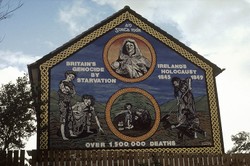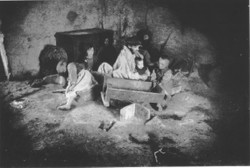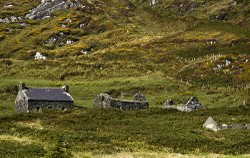During 1984, President Reagan embarked on a four day state visit to Ireland.
This was the period when IRA paramilitary maneuvers were at their zenith. Bombs continued to explode in mainland Britain, including one in Brighton, which nearly killed Prime Minister Margaret Thatcher. Northern Ireland - and Belfast in particular - was practically a war-zone.
As a statesman, Reagan publicly condemned the violence, expressed support for the New Ireland Forum (which was going to bring about peace until Mrs Thatcher equally publicly insulted Irish Taoiseach Garrett FitzGerald), but ultimately stated quite firmly that the USA would not interfere with the conflict.
It was a statement which must have been heard with incredulity in the higher echelons of the British government; and wry smiles throughout republican Ulster.
Just in case anyone else hadn't quite caught up with the plot, the reality was made stark later in the year. The US Department of Justice won a court battle to officially name the IRA as 'foreign principles', in other words allies worthy of assistance.
For decades, fund-raising amongst the American public had been the primary source of finance for the IRA. All those descendants of the Great Hunger's migration were more than willing to put their hands in their pockets to continue the great fight.
The USA was where Michael Collins sold all of those bonds to finance the new Irish Republic in the 1920s. (And it was the first foreign nation to accept Eire as an independent state.)
Now one more Famine descendant made it a downright obligation. That legal battle forced the Irish Northern Aid Committee (NORAID) - a US body - to openly fund the IRA. That bomb which nearly took out Mrs Thatcher was paid for in America.
Thus the legacy of the Great Hunger went on.




















 St Tydecho's Churches in West Waleson 09/03/2014
St Tydecho's Churches in West Waleson 09/03/2014
 Goodies for an Outlander Premiere Partyon 03/06/2015
Goodies for an Outlander Premiere Partyon 03/06/2015
 Holocaust Memorial Day Interview with Rainer Höss, Grandson of Rudolf Architect of Auschwitzon 01/24/2015
Holocaust Memorial Day Interview with Rainer Höss, Grandson of Rudolf Architect of Auschwitzon 01/24/2015
 Romantic Valentine Gifts for an Outlander Fanon 01/16/2015
Romantic Valentine Gifts for an Outlander Fanon 01/16/2015



How has the Great Irish Famine affected you?
I guess a lot depended upon the circumstances back in Ireland. While it was dire for many, for some it really was terrible indeed, particularly when they had been kicked out of their homes.
Some went piecemeal, but some families went as groups. My mother's gran's family came from Sligo, and her family went along with her uncle's family and their cousins. all went as a clan and headed for Manchester.
I didn't know that, re the redefinition of words. It just shows how the Hunger had an effect upon the lexicon too.
Though I knew that families tended to emigrate piecemeal, with younger people following in the trail of older siblings, then parents following, I'd not extrapolated that to realise that there were clusters from one area. I know that Tipton, in the Black Country, had a sizable community of people from Tipperary. 'It's a Long Way to Tipperary' was written by a lad from Tipton with reference to his grandmother.
Yes, you do have to feel for poor Welsh Brunty, never quite knowing his roots.
As a historian you might be interested to know that even today some elderly Irish tend to call an occurrence of blight, however small, a famine. My ninety three year old mother in law, who comes from County Mayo and was the daughter of a farmer, told me that there were cases of potato famine when she was young. That was the 1930s. She did not think that there was starvation, but famine was the term that she used.
You might also be interested to know that among the Irish there are established immigrant trails. For example, the Catholic community of Stretford, where I live, contains a disproportionately large number of people who originate in Mayo [hence my in-laws] whereas the Irish community in Leeds has many from county Tyrone. It is due to people going where they already have friends and relatives, and the roots of this may go back to the famine emigrations.
A language like Welsh! This could be Cornish, Manx or Breton.
The Brontes weren't even Anglo-Irish. Their mother was Cornish. Kerno-Irish? Downright Celtic anyway!
There's an argument to be made that there's some Welsh blood in there too. You know how Heathcliff was found on a Liverpool dock, unable to speak English and generally disheveled? That came from real life. It was Patrick's father or grandfather, who washed up on an Irish shore as a young boy. He spoke a bizarre language, which someone said sounded like Welsh.
Therefore the boy was named Welsh and taken in by the Brunty family. He was way too young to tell them anything about himself, hence Welsh Brunty remained his name.
Pembrokeshire remains a very English corner of Wales. Those early Norman settlers were required to keep hold of it, as it secured a section of the west Welsh coastline, which could be used to attack Ireland. There were fears that the Welsh might intervene otherwise. Though I agree that Celtic unity has historically been a myth.
When the Norman colony nearly died out. Loads of Dutch settlers were imported there instead. Then English. Pembrokeshire has always been very resistant to incorporating anything of the Welsh language.
Your Northern Irish Protestant lady doesn't surprise me one bit. As an historian, I'm forever meeting people who know nothing about why they are where they are.
Now the fact about Bronte is interesting, and I knew it not. We can now add the Brontes to the list of Anglo-Irish writers. There have been so many able writers from this group.
I was not aware that there was anti-Irish feeling in parts of Wales, but Celtic solidarity has always been a bit of a myth. Interestingly, the first Normans in Ireland came with Strongbow de Clare, Earl of Pembroke, and he took a mixture of Normans and Welsh with him. Many English settlers followed, particularly in Strongbow's domains of the South East.
There are too few British who know any Irish history. An ex-colleague of mine, a science teacher, pleasant woman, Northern Irish Protestant, surprised me when she did not know why the Protestant/unionists in Northern Ireland had all the best land. I thad to explain the sixteenth century settlements and the land grab that happened.
Bizarrely, I've read some reports where the Welsh - in the west and south - could be anti-Irish too. This was only where jobs were scarce and the Welsh themselves besieged by the sort of mentality that you highlighted in your comment. It was less to do with the Irish as a nation, and more to do with half-starved and desperate groups of people wandering around the Welsh landscape.
Patrick Brunty felt the need to change the spelling of his name to Brontë. He was Irish born and bred, but now resident in England. Brunty and Brontë were pronounced the same, but the first was undeniably Irish, while the second looked German. Then his literary daughters went and made the name famous.
The blight certainly hit the Scottish Isles after it arrived in Ireland and then it reached the mainland.
Animosity to the Irish in Britain tends to be a very middle and upper class phenomenon. Many working class people tended to have less ill feeling, as they were living in the same communities as these supposedly inferior people. Catholics were intermarrying so much with the Irish that they were becoming a mixed ethnic group and could not have the same animosity to the Irish as others had. But middle class people often made a point of denying that they had Irish blood, as they identified with the British power structure, which was anti-Irish, as it was in possession of Irish lands. We had a lad at school when I was sixteen, whose name was Sullivan, but who totally denied having Irish blood.
What also got involved was racial theory. The theory of Nordic/Germanic racial superiority evolved in France as a way of justifying the claims to superiority made by the French aristocracy, who are of Germanic descent. As the Germanic peoples were said to be superior, it became necessary for the English to prove themselves pure Germanic. Hence the theory that the Celts/Britons were all murdered or driven to Wales by the Saxons, but the Irish were irredeemably" Celtic" and hence in the racist view racially inferior. Clearly, being racially pure English implied superiority, and if you believe this you did not want your children intermarrying with supposedly racially inferior people.
Frank - I've gone on about the arguments for and against calling it a genocide in another article. It's linked at the top of the right-hand scrollbar. So I won't repeat them here, if that's alright?
As for general xenophobia versus rich against the poor. Yes, the latter is usually how it works. But the rich tend to be the ones in control of information, so they can whip up hatred that way.
I don't think that the British people en masse detested the Irish, but they were certainly subject to a lot of propaganda in the press. It's a little like how the drip-drip of Islamophobia works now. The Irish were illustrated as baboons, or as drunken, lazy individuals, who'd rather take charity than work a day in their lives. A lot of people believed that.
Also several areas of Britain were also subject to famine at the time. They survived it because basically they had all of the food being shipped out of Ireland! That wasn't viewed as charity. It was seen as relief.
Frank - You can add to this the practice of splitting all holdings equally between all children. In Britain, it tended to be the eldest son who got everything. In Ireland, everyone got their share. You can imagine how quickly even a large amount of land became small over just a few generations.
One of the really eye-opening things is that so many notes were taken on this particular Late Blight - and the devastation so clear for all to see - that it became the basis for much of our modern day knowledge about it. Over the years, that's obviously been built upon, but this is where that scientific study began. Just another unforeseen legacy!